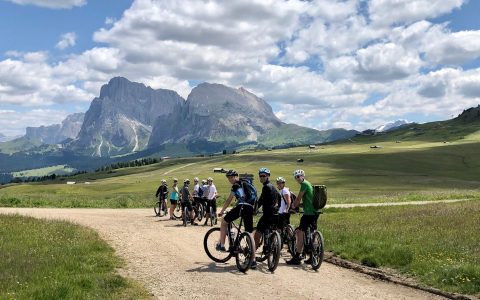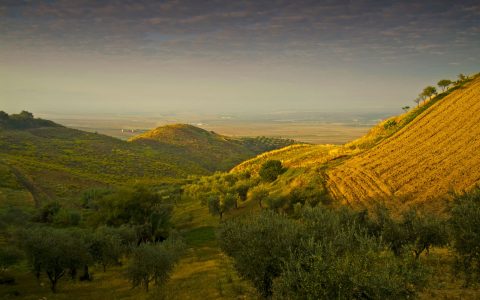In Deep:
A Brief History of Ostuni
Featuring a walled acropolis and whitewashed buildings that stand as a testament to its Eastern influences, Ostuni is (rather rightly) known as La Perla Bianca, “The White Pearl.”

We like to describe Puglia as “Italy, with Greek parents,” and no place epitomizes this more than Ostuni—you could be forgiven for thinking you’re in Greece! Historically, the town has changed hands many times: it has been ruled by the Aragonese, Angevins, Swabians, Normans, Byzantines, Longobards, Spanish and Bourbons. Ostuni is built on three hills and is a perfect example of Pugliese town architecture. Its stratified shape exhibits the different stages of architecture added by each ruling civilization.
Ostuni’s winding alleys are covered in bougainvillea and other lush hanging plants and flowers that perfectly accent the brightly coloured doors and windows. The town’s much-photographed Piazza della Libertà boasts a cathedral that was built in the 15th century in the late Gothic/early Renaissance style. The town is also known for its clay figurines, called fischietti, which are actually functioning whistles!
Experience Puglia With B&R
Scheduled Group Biking Trip
Stunning, sun-drenched coastline, sumptuous, sauce-drenched food and mile upon mile of soul-stirring rides on quiet roads make our Puglia Biking trip a veritable paradise on wheels.
DETAILED ITINERARYPrivate Walking Trip
Our Private Puglia & Basilicata Walking trip features sublime coastal walks, whitewashed towns, fortified farms, and distinctive stone trulli, while the culinary highlights include fresh seafood, local wine and olive oil.
DETAILED ITINERARYThe Caves of Santa Maria di Agnano

Ostuni is home to the caves of Santa Maria di Agnano. These caves are a testament to the origins of human life and settlement in Puglia, with evidence dating back to the Palaeolithic era. Providing proof of a Neolithic cult occupation, a hearth, cereals and schematic images of a human face on two vase necks were found in the caves, dating back to the first half of the 5th millennium.
Research that began in 1991 by Donato Coppola (no, not that Coppola) exposed two important burial sites dating back to 24,000 BC. At one site, the remains of a 20-year-old pregnant woman wearing bracelets made of perforated shells were found in a burial ditch, along with the remains of an unborn child in the advanced stages of development. Also included in the tomb was a headdress made of more than 100 seashells covered with red ochre, as well as stone tools and remnants of wildfire.
Coppola’s research led to the conclusion that for 25,000 years the caves were the site of rites and cults dedicated to females.
The Days of Delia
The remains of the pregnant woman were given a name—Delia. During Delia’s time, horses and wild ox were the main prey available. The landscape was coniferous, but with few trees, and the climate was dry and arid, but cold.
One can imagine Delia overlooking the vast plains (much larger than the current landscape because of lower sea levels) in which large herds of horses and oxen grazed. The caves of Agnano were probably chosen for settlement due to their position above sea level, offering great views of the plains so hunters could follow the movements of the herd, ensuring both their hunting success and their ultimate survival. A lot of time was dedicated not only to hunting and gathering but also to rituals that were carried out in the caves, especially burials.
MORE FROM Italy + Puglia

Reading for the Road: Books About Florence
Tuscany
New Trip Spotlight: Venice to Verona Biking
Veneto
Cuisine 102: Tuscan Delicacies
Tuscany
How to Best Experience the Natural Wonders of Umbria
Umbria
Notes from the Road: A Research Trip in Sicily
Sicily
Umbria’s 3 Essential Cities
Umbria
Sustainable Cuisine in Northern Italy: In Conversation with Michelin-starred Chef Norbert Niederkofler
Dolomites
The Origin of the Negroni: Florence’s Favourite Cocktail
Tuscany
The 10 Best Restaurants in Florence
Tuscany
Giro-E: Racing the Giro d’Italia Route on E-bikes
Italy
The Best Villas in Italy: Amalfi, Tuscany and Umbria
Amalfi Coast
A Taste of Piemonte with Silvia Altare
Piemonte
Finding Prosperity in Food & Community in Rural Italy
Puglia
5 Unmissable Tuscan Hilltop Towns
Tuscany
The Most Incredible Hikes in Italy’s Dolomite Mountains
Dolomites
The Best Hotels in Rome for Every Taste
Rome
A Day in Florence: Rediscovering the City with Family Post-Lockdown
Tuscany
The Slow Fund: Replanting Trees in the Dolomites with Wow Nature
Dolomites
Why Your Next Private Family Vacation Should Be to the Dolomites
Dolomites


